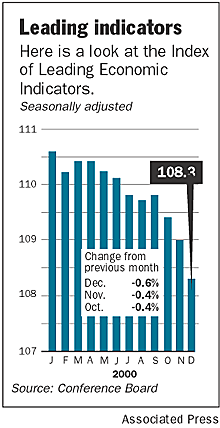Associated Press
NEW YORK — A key gauge of U.S. economic activity plunged 0.6 percent in December, the largest drop in five years and a signal of continued weakness in the U.S. economy.
The New York-based Conference Board said its Index of Leading Economic Indicators, which has been statistically revised and rebased, fell to 108.3 last month after two consecutive drops of 0.4 percent in October and November.
Three consecutive declines in the index traditionally is seen by analysts as a signal that the U.S. economy is headed into recession.
But Conference Board economist Ken Goldstein said in a statement accompanying the report that "the cumulative decline is ... still below the threshold of what would be considered a recessionary signal."
He added: "The overall signal remains one of moderation in the pace of economic activity, but no recession looming on the horizon."
The decline in December was the largest since a 0.7 percent drop in January 1996, the Conference Board said.
Analysts had expected a 0.3 percent drop in the index in December, based on the previous statistical base. Goldstein said this was "right on target" with the revised reading.
David H. Resler, chief economist at Nomura Securities in New York, said the report was "further confirmation" of earlier data on economic weakness.
He said he expected the Federal Reserve to lower interest rates further when it meets at the end of January, but said it was too soon to predict if there would be a half-point or quarter-point easing.
The Fed lowered interest rates one-half percentage point earlier this month fearing that economic activity was slowing precipitously, threatening the nation’s economic expansion, currently in its 119th month and the longest in U.S. history.
David Orr, chief economist at First Union Corp. in Charlotte, N.C., noted that the market tends to discount the report on leading indicators because the components’ performance is known before the index itself is calculated. This, he said, "misses its influence on the perceptions of the general public and politicians."
He added: "The public is now hearing loud and clear that economic growth has stalled and that the risks of serious trouble are rising. No doubt, such negative news, in turn, affects consumer confidence, which then can affect consumer spending."
That spending accounts for about two-thirds of the U.S. economy.
The Conference Board annually revises its benchmark, bringing all three indexes — leading, coincident and lagging — in line with the latest data on their components’ parts. This year the board said its changes include an update in statistical methodology on the relationship among the three indexes.
The New York business group said that seven of 10 components of the leading index declined last month: weekly manufacturing hours, consumer expectations, the spread in interest rates, stock prices, initial claims for unemployment insurance, manufacturers’ orders for non-defense capital goods, and material and building permits.
The index of coincident indicators, which measures current economic activity, rose 0.1 percent in December to 116.6 after rising the same amount in November, the report said.
The index of lagging indicators, reflecting changes that have occurred, was down 0.1 percent in December to 107.4 after rising 0.4 percent the month before.
[back to top] |

